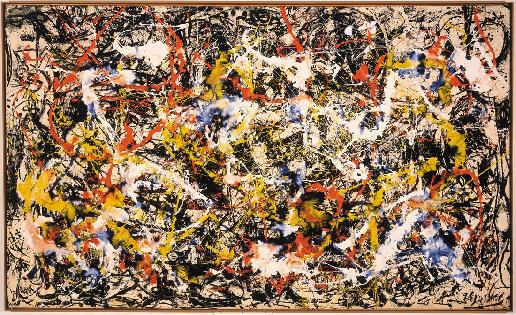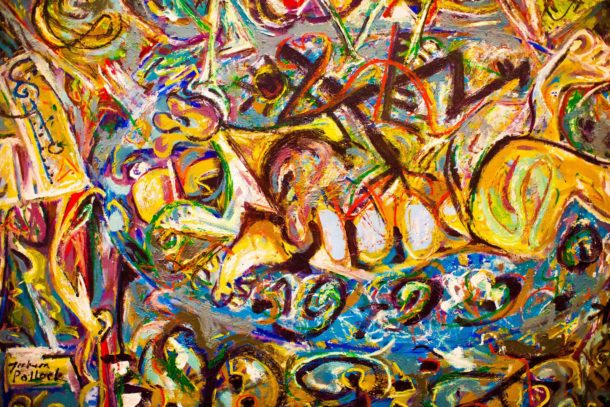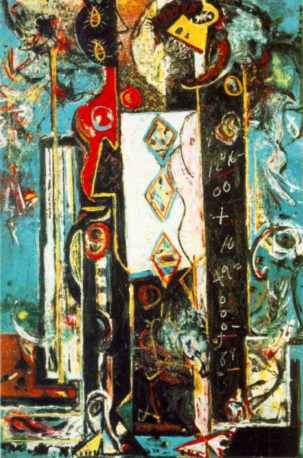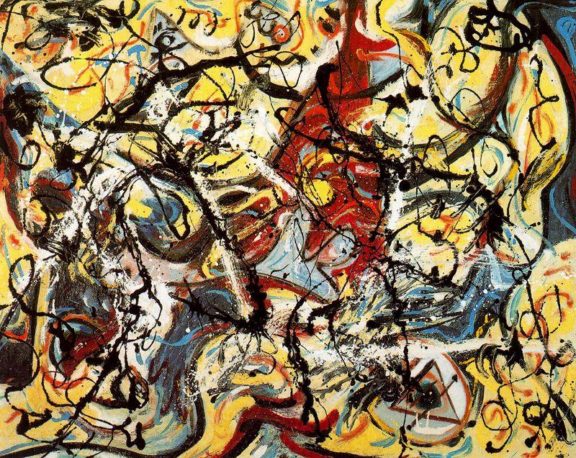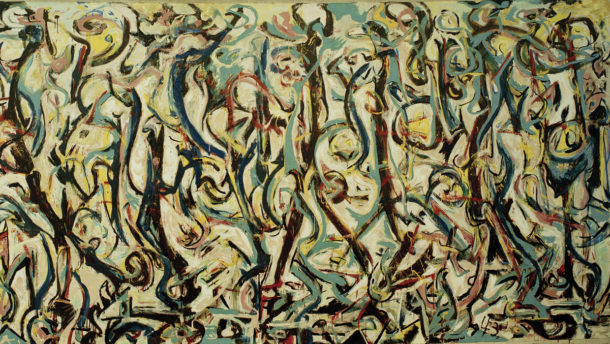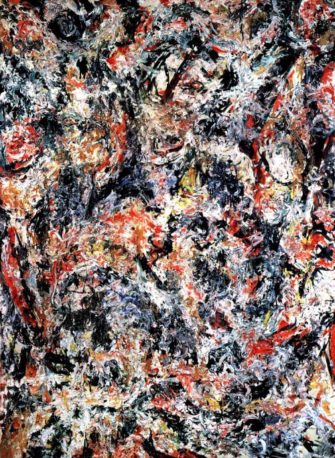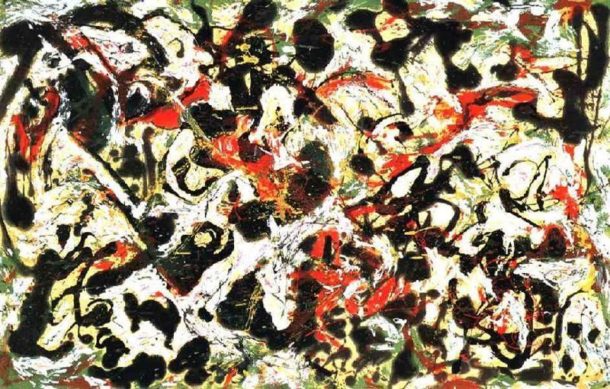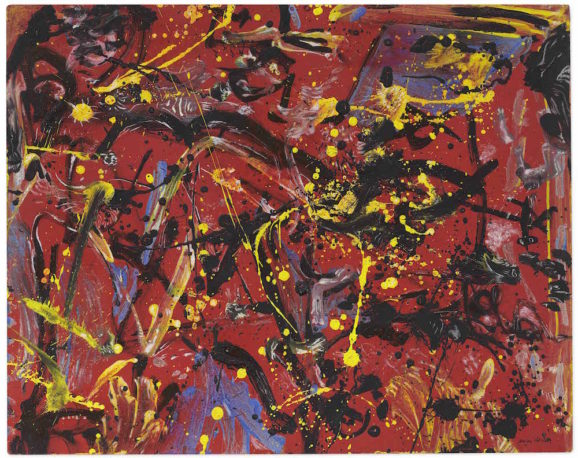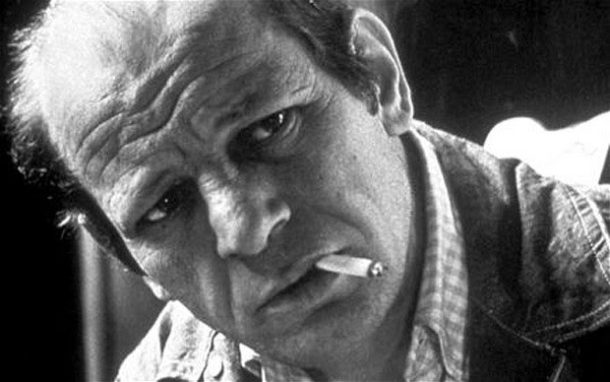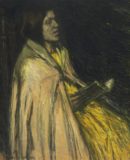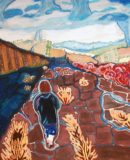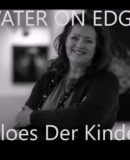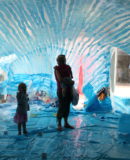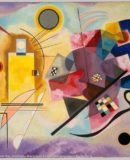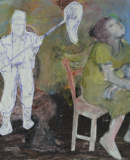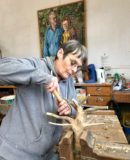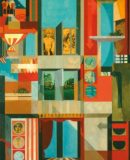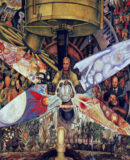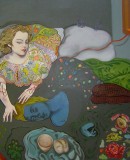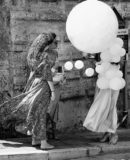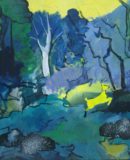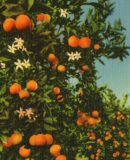World Fine Art Professionals and their Key-Pieces, 290 - Jackson Pollock
World Fine Art Professionals and their Key-Pieces, 290 – Jackson Pollock
We are all familiar with Jackson Pollock’s “drip” paintings. While dancing and jumping and sometimes standing quietly, Pollock dropped the paint from above on the canvas that was on the floor. His works fetch high prices, a hundred million dollars, sometimes even more.
Pollock’s most famous paintings were made between 1947 and 1950. In the August 1949 issue of Life magazine, a fold-out page of Pollock’s work appeared with the headline “Is He the Greatest Living Painter in the United States?” In 1952 his work from the period 1948 – 1951 was shown for the first time in Paris at Studio Paul Facchetti.
Native American culture
Paul Jackson Pollock was born in Cody, Wyoming, in 1912, the youngest of five sons. His father was born with the surname McCoy, but took the surname of his adoptive parents. His mother and father were Presbyterian; they were of Irish and Scotch-Irish descent respectively. LeRoy Pollock was a farmer and later a government surveyor who moved for various jobs.
When Jackson was 10 months old he moved to San Diego. He then grew up in Arizona and Chico, California. He sometimes went with his father in the period that he was a surveyor of land and Jackson at the same time explored Native American culture. As a teenager he was interested in the Mexican muralists, especially José Clemente Orozco, whose fresco Prometheus he would later call “the greatest painting in North America”.
New York
While living in Los Angeles, he enrolled at Manual Arts High School, but was expelled from there after a while. That had happened before, at another school. In 1930 he moved, following his elder brother Charles Pollock, to New York City, where they both studied with Thomas Hart Benton at the Art Students League. Benton inspired them, not so much because of his country paintings, but mainly because of the rhythmic use of paint. In the early 1930’s, Pollock spent a summer in the western United States with fellow art student Glen Rounds and Benton.
In an experimental atelier in New York City, Jackson was introduced to the use of liquid paint by Mexican muralist David Alfaro Siqueiros in 1936. Pouring paint, he made the works ‘Male and Female’ and ‘Composition with Pouring I’. After moving to Springs on the far western tip of Long Island, he began painting his canvases on the studio floor and developed what was later called his drip technique.
Jungian psychotherapy
From 1938 to 1942, Pollock worked for a New Deal art project. During this time Pollock tried to do something about his alcoholism. He underwent Jungian psychotherapy with Dr. Joseph L. Henderson and later Dr. Violet Staub de Laszlo. Henderson involved his art and encouraged him to draw pictures of his drinking needs. Jungian concepts and archetypes emerged in the work. In 1943 he signed a gallery contract with Peggy Guggenheim. He was commissioned to create a 2.4 by 6.1 m mural at the entrance to her new mansion.
On the advice of her friend and adviser Marcel Duchamp, Pollock painted the work on canvas instead of the wall, so that it would be portable. After seeing the large mural, art critic Clement Greenberg wrote, “I took one look and I thought, ‘That’s great art,’ and I knew Jackson was the greatest painter this country had produced.” In the catalog for his first exhibition, Pollock’s talent was described as “volcanic. It has fire. It is unpredictable. It is undisciplined. It runs by itself into a mineral wonder, not yet crystallized.”
Pollock’s work after 1951 was darker in color, some works were black. These paintings are called his ‘Black pourings’ and when he displayed them at the Betty Parsons Gallery in New York, they were not sold. He returned to the use of color and continued with figurative elements. The demand from collectors for his work remained high. In response to this pressure, along with personal frustration, he started drinking heavily again.
Lee Krasner
In 1942 he exhibited together with Lee Krasner at the McMillen Gallery. Krasner was intrigued by Pollock’s work and went to his apartment unannounced to meet him after the gallery show. One thing led to another. In October 1945, Pollock and Lee Krasner were married in a church with two witnesses who attended the event. With the help of a down payment loan from Peggy Guggenheim, they bought a timber-framed house and a barn in Springs. Pollock converted the barn into a studio. In that room he perfected his drip technique.
Krasner helped Pollock develop his work by adhering to the principles of modernist painting. She also made contact with collectors and critics. One art dealer commented, “There would never have been a Jackson Pollock without Lee Pollock”.
In 1955 Pollock painted Scent and Search, his last two paintings. Meanwhile, Jackson and Lee’s relationship was crumbling because of Jackson’s drinking and an affair Jackson had.
Car accident
At 10:15 p.m. on August 11, 1956, Pollock died in a car accident in his Oldsmobile convertible while driving under the influence of alcohol. Krasner was visiting friends in Europe and she abruptly returned when she heard the news from a friend. In December 1956, four months after his death, Pollock was given a memorial display at the Museum of Modern Art (MoMA) in New York City. In 1967 a larger, more extensive exhibition of his work was held there. In 1998 and 1999 his work was honored with large-scale retrospective exhibitions at MoMA and The Tate in London.
For the rest of her life, his widow Lee Krasner managed his estate, ensuring that Pollock’s reputation remained strong despite changing trends in the art world. The couple were buried in the Green River Cemetery in Springs with a large rock marking his grave and a smaller one marking hers.
Images
1) Convergence, 2) Pasiphaë, 3) Male and Female, 4) Composition with Pouring I, 5) Mural Peggy Guggenheim, 6) Black Pouring, 7) Scent, 8) Search, 9) Red Composition, 10) Jackson Pollock
https://ifthenisnow.eu/nl/personen/jackson-pollock
Disclaimer: The views, opinions and positions expressed within this guest article are those of the author Walter van Teeffelen alone and do not represent those of the Marbella Marbella website. The accuracy, completeness and validity of any statements made within this article are not guaranteed. We accept no liability for any errors, omissions or representations. The copyright of this content belongs to Walter van Teeffelen and any liability with regards to infringement of intellectual property rights remains with the author.

